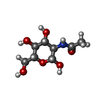[English] 日本語
 Yorodumi
Yorodumi- EMDB-46653: Cryo-EM structure of HIV-1 BG505 SOSIP.664 Env bound to 3-sCD4, 3... -
+ Open data
Open data
- Basic information
Basic information
| Entry |  | |||||||||
|---|---|---|---|---|---|---|---|---|---|---|
| Title | Cryo-EM structure of HIV-1 BG505 SOSIP.664 Env bound to 3-sCD4, 3-VRC34.01 Fab with one gp120 rotated | |||||||||
 Map data Map data | HIV-1 BG505 SOSIP Env with sCD4 and VRC34.01 Fabs | |||||||||
 Sample Sample |
| |||||||||
 Keywords Keywords | Recombinant protein / HIV-1 Env / CD4 / fusion peptide binning antibody VRC34.01 / Vaccine / VIRAL PROTEIN / VIRAL PROTEIN-IMMUNE SYSTEM complex | |||||||||
| Function / homology |  Function and homology information Function and homology informationhelper T cell enhancement of adaptive immune response / interleukin-16 binding / interleukin-16 receptor activity / response to methamphetamine hydrochloride / maintenance of protein location in cell / cellular response to ionomycin / T cell selection / MHC class II protein binding / positive regulation of kinase activity / interleukin-15-mediated signaling pathway ...helper T cell enhancement of adaptive immune response / interleukin-16 binding / interleukin-16 receptor activity / response to methamphetamine hydrochloride / maintenance of protein location in cell / cellular response to ionomycin / T cell selection / MHC class II protein binding / positive regulation of kinase activity / interleukin-15-mediated signaling pathway / cellular response to granulocyte macrophage colony-stimulating factor stimulus / positive regulation of monocyte differentiation / Nef Mediated CD4 Down-regulation / Alpha-defensins / response to vitamin D / regulation of T cell activation / extracellular matrix structural constituent / Other interleukin signaling / T cell receptor complex / enzyme-linked receptor protein signaling pathway / Translocation of ZAP-70 to Immunological synapse / Phosphorylation of CD3 and TCR zeta chains / positive regulation of calcium ion transport into cytosol / positive regulation of protein kinase activity / regulation of calcium ion transport / Generation of second messenger molecules / macrophage differentiation / T cell differentiation / immunoglobulin binding / Co-inhibition by PD-1 / Binding and entry of HIV virion / coreceptor activity / positive regulation of plasma membrane raft polarization / positive regulation of receptor clustering / positive regulation of T cell proliferation / positive regulation of interleukin-2 production / positive regulation of calcium-mediated signaling / protein tyrosine kinase binding / cell surface receptor protein tyrosine kinase signaling pathway / Vpu mediated degradation of CD4 / host cell endosome membrane / calcium-mediated signaling / clathrin-coated endocytic vesicle membrane / positive regulation of protein phosphorylation / MHC class II protein complex binding / Cargo recognition for clathrin-mediated endocytosis / Downstream TCR signaling / transmembrane signaling receptor activity / Clathrin-mediated endocytosis / response to estradiol / signaling receptor activity / virus receptor activity / response to ethanol / defense response to Gram-negative bacterium / clathrin-dependent endocytosis of virus by host cell / adaptive immune response / positive regulation of viral entry into host cell / early endosome / cell surface receptor signaling pathway / positive regulation of ERK1 and ERK2 cascade / positive regulation of canonical NF-kappaB signal transduction / cell adhesion / positive regulation of MAPK cascade / viral protein processing / immune response / membrane raft / endoplasmic reticulum lumen / fusion of virus membrane with host plasma membrane / external side of plasma membrane / fusion of virus membrane with host endosome membrane / lipid binding / viral envelope / endoplasmic reticulum membrane / symbiont entry into host cell / protein kinase binding / positive regulation of DNA-templated transcription / virion attachment to host cell / host cell plasma membrane / virion membrane / structural molecule activity / enzyme binding / signal transduction / protein homodimerization activity / zinc ion binding / identical protein binding / membrane / plasma membrane Similarity search - Function | |||||||||
| Biological species |   Human immunodeficiency virus 1 / Human immunodeficiency virus 1 /  Homo sapiens (human) Homo sapiens (human) | |||||||||
| Method | single particle reconstruction / cryo EM / Resolution: 4.06 Å | |||||||||
 Authors Authors | Thakur B / Acharya P | |||||||||
| Funding support |  United States, 2 items United States, 2 items
| |||||||||
 Citation Citation |  Journal: Nat Commun / Year: 2025 Journal: Nat Commun / Year: 2025Title: Conformational trajectory of the HIV-1 fusion peptide during CD4-induced envelope opening. Authors: Bhishem Thakur / Revansiddha H Katte / Wang Xu / Katarzyna Janowska / Salam Sammour / Rory Henderson / Maolin Lu / Peter D Kwong / Priyamvada Acharya /  Abstract: The hydrophobic fusion peptide (FP), a critical component of the HIV-1 entry machinery, is located at the N terminus of the envelope (Env) gp41 subunit. The receptor-binding gp120 subunit of Env ...The hydrophobic fusion peptide (FP), a critical component of the HIV-1 entry machinery, is located at the N terminus of the envelope (Env) gp41 subunit. The receptor-binding gp120 subunit of Env forms a heterodimer with gp41. The gp120/gp41 heterodimer assembles into a homotrimer, in which FP is accessible for antibody binding. Env conformational changes or "opening" that follow receptor binding result in FP relocating to a newly formed interprotomer pocket at the gp41-gp120 interface where it is sterically inaccessible to antibodies. The mechanistic steps connecting the entry-related transition of antibody accessible-to-inaccessible FP configurations remain unresolved. Here, using SOSIP-stabilized Env ectodomains, we visualize that the FP remains accessible for antibody binding despite substantial receptor-induced Env opening. We delineate stepwise Env opening from its closed state to a functional CD4-bound symmetrically open Env in which we show that FP was accessible for antibody binding. We define downstream re-organizations that lead to the formation of a gp120/gp41 cavity into which the FP buries to become inaccessible for antibody binding. These findings improve our understanding of HIV-1 entry and delineate the entry-related conformational trajectory of a key site of HIV vulnerability to neutralizing antibody. | |||||||||
| History |
|
- Structure visualization
Structure visualization
| Supplemental images |
|---|
- Downloads & links
Downloads & links
-EMDB archive
| Map data |  emd_46653.map.gz emd_46653.map.gz | 113.2 MB |  EMDB map data format EMDB map data format | |
|---|---|---|---|---|
| Header (meta data) |  emd-46653-v30.xml emd-46653-v30.xml emd-46653.xml emd-46653.xml | 27.3 KB 27.3 KB | Display Display |  EMDB header EMDB header |
| FSC (resolution estimation) |  emd_46653_fsc.xml emd_46653_fsc.xml | 10.6 KB | Display |  FSC data file FSC data file |
| Images |  emd_46653.png emd_46653.png | 84.2 KB | ||
| Filedesc metadata |  emd-46653.cif.gz emd-46653.cif.gz | 7.7 KB | ||
| Others |  emd_46653_half_map_1.map.gz emd_46653_half_map_1.map.gz emd_46653_half_map_2.map.gz emd_46653_half_map_2.map.gz | 115.9 MB 115.9 MB | ||
| Archive directory |  http://ftp.pdbj.org/pub/emdb/structures/EMD-46653 http://ftp.pdbj.org/pub/emdb/structures/EMD-46653 ftp://ftp.pdbj.org/pub/emdb/structures/EMD-46653 ftp://ftp.pdbj.org/pub/emdb/structures/EMD-46653 | HTTPS FTP |
-Validation report
| Summary document |  emd_46653_validation.pdf.gz emd_46653_validation.pdf.gz | 911 KB | Display |  EMDB validaton report EMDB validaton report |
|---|---|---|---|---|
| Full document |  emd_46653_full_validation.pdf.gz emd_46653_full_validation.pdf.gz | 910.6 KB | Display | |
| Data in XML |  emd_46653_validation.xml.gz emd_46653_validation.xml.gz | 19.3 KB | Display | |
| Data in CIF |  emd_46653_validation.cif.gz emd_46653_validation.cif.gz | 24.9 KB | Display | |
| Arichive directory |  https://ftp.pdbj.org/pub/emdb/validation_reports/EMD-46653 https://ftp.pdbj.org/pub/emdb/validation_reports/EMD-46653 ftp://ftp.pdbj.org/pub/emdb/validation_reports/EMD-46653 ftp://ftp.pdbj.org/pub/emdb/validation_reports/EMD-46653 | HTTPS FTP |
-Related structure data
| Related structure data |  9d8yMC  9d90C  9d98C M: atomic model generated by this map C: citing same article ( |
|---|---|
| Similar structure data | Similarity search - Function & homology  F&H Search F&H Search |
- Links
Links
| EMDB pages |  EMDB (EBI/PDBe) / EMDB (EBI/PDBe) /  EMDataResource EMDataResource |
|---|---|
| Related items in Molecule of the Month |
- Map
Map
| File |  Download / File: emd_46653.map.gz / Format: CCP4 / Size: 125 MB / Type: IMAGE STORED AS FLOATING POINT NUMBER (4 BYTES) Download / File: emd_46653.map.gz / Format: CCP4 / Size: 125 MB / Type: IMAGE STORED AS FLOATING POINT NUMBER (4 BYTES) | ||||||||||||||||||||||||||||||||||||
|---|---|---|---|---|---|---|---|---|---|---|---|---|---|---|---|---|---|---|---|---|---|---|---|---|---|---|---|---|---|---|---|---|---|---|---|---|---|
| Annotation | HIV-1 BG505 SOSIP Env with sCD4 and VRC34.01 Fabs | ||||||||||||||||||||||||||||||||||||
| Projections & slices | Image control
Images are generated by Spider. | ||||||||||||||||||||||||||||||||||||
| Voxel size | X=Y=Z: 1.08 Å | ||||||||||||||||||||||||||||||||||||
| Density |
| ||||||||||||||||||||||||||||||||||||
| Symmetry | Space group: 1 | ||||||||||||||||||||||||||||||||||||
| Details | EMDB XML:
|
-Supplemental data
-Half map: #2
| File | emd_46653_half_map_1.map | ||||||||||||
|---|---|---|---|---|---|---|---|---|---|---|---|---|---|
| Projections & Slices |
| ||||||||||||
| Density Histograms |
-Half map: #1
| File | emd_46653_half_map_2.map | ||||||||||||
|---|---|---|---|---|---|---|---|---|---|---|---|---|---|
| Projections & Slices |
| ||||||||||||
| Density Histograms |
- Sample components
Sample components
+Entire : HIV-1 BG505 SOSIP.664 Env in complex with 3 molecules of sCD4 and...
+Supramolecule #1: HIV-1 BG505 SOSIP.664 Env in complex with 3 molecules of sCD4 and...
+Supramolecule #2: HIV-1 BG505 SOSIP.664
+Supramolecule #3: 4-domain CD4
+Supramolecule #4: VRC34.01 Fab
+Macromolecule #1: Envelope glycoprotein gp160
+Macromolecule #2: Envelope glycoprotein gp160
+Macromolecule #3: VRC34.01 Fab Heavy Chain
+Macromolecule #4: VRC34.01 Fab Light Chain
+Macromolecule #5: T-cell surface glycoprotein CD4
+Macromolecule #8: 2-acetamido-2-deoxy-beta-D-glucopyranose
-Experimental details
-Structure determination
| Method | cryo EM |
|---|---|
 Processing Processing | single particle reconstruction |
| Aggregation state | particle |
- Sample preparation
Sample preparation
| Buffer | pH: 8 |
|---|---|
| Grid | Model: Quantifoil R1.2/1.3 / Material: COPPER / Mesh: 300 / Support film - Material: CARBON / Support film - topology: HOLEY / Pretreatment - Type: GLOW DISCHARGE / Pretreatment - Time: 20 sec. |
| Vitrification | Cryogen name: ETHANE / Chamber humidity: 95 % / Chamber temperature: 295 K / Instrument: LEICA EM GP |
- Electron microscopy
Electron microscopy
| Microscope | TFS KRIOS |
|---|---|
| Image recording | Film or detector model: GATAN K3 (6k x 4k) / Average electron dose: 59.1 e/Å2 |
| Electron beam | Acceleration voltage: 300 kV / Electron source:  FIELD EMISSION GUN FIELD EMISSION GUN |
| Electron optics | Illumination mode: FLOOD BEAM / Imaging mode: BRIGHT FIELD / Nominal defocus max: 2.4 µm / Nominal defocus min: 0.8 µm |
| Experimental equipment |  Model: Titan Krios / Image courtesy: FEI Company |
+ Image processing
Image processing
-Atomic model buiding 1
| Refinement | Space: REAL |
|---|---|
| Output model |  PDB-9d8y: |
 Movie
Movie Controller
Controller











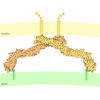




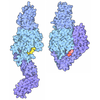

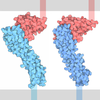

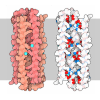


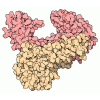
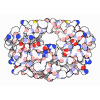
 X (Sec.)
X (Sec.) Y (Row.)
Y (Row.) Z (Col.)
Z (Col.)




































